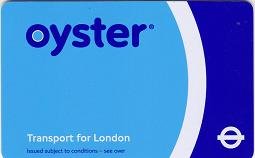How to Travel Smart, Oyster vs. Contactless & Fare Capping.
What Difference Between Oyster and Contactless?
Oyster Card Explained
An Oyster card is a smartcard used for pay-as-you-go travel on public transportation in London, primarily managed by Transport for London (TFL). It’s a convenient way to pay for travel on London’s buses, trams, the Tube (London Underground), Docklands Light Railway (DLR), London Overground, TfL Rail, Emirates Air Line, River Bus services, and some National Rail services within the Greater London area.
How Does It Work
The card works by touching it on yellow card readers at the start and end of your journey (except on buses and trams, as it is a fixed fare, you don’t need to tap out). The system automatically calculates the correct fare for your journey based on the zones traveled and any applicable fare caps. You can also use the Oyster card to pay for single journeys, daily caps, and weekly caps, providing flexibility and potentially saving money compared to purchasing paper tickets.
Standard Oyster Card
- Advantages:
- Can be used by anyone, including residents and visitors.
- No expiration date, so you can keep and reuse it on future visits to London.
- After 4th September 2022 the card will cost £7 ($9 €8), and is non-refundable.
- Same fares as Visitor Oyster Card.
- Can be topped up online, at ticket machines, and at Oyster Ticket Stops.
- Disadvantages:
- No special offers or discounts available for visitors.
- No pre-loaded credit or discounts
Visitor Oyster Card
- Advantages:
- Pre-loaded with credit (£10, £15, £20, £25, £30, £35, £40, or £50) depending on the card value purchased.
- Offers special discounts and offers at selected restaurants, shops, and attractions.
- Can be used right away without needing to top up.
- No refundable deposit, but any remaining balance can be transferred to another Oyster Card or refunded (minus a £5 admin fee).
- Can be ordered in advance and delivered to your home address before your trip,(This applies only to UK residents, TFL do not post to addresses outside of the UK).
- Disadvantages:
- Higher initial cost due to the non-refundable card fee £5 ($6.5 €6).
- Can only be used by visitors to London.
- Expires after one year of inactivity if not used.
- It has to be mentioned, but getting a Visitor Oyster card is not the easiest task for the average visitor to the UK. The card may be purchased prior to arrival in the UK via agents within different countries.
Contactless Explained: The Different Forms
You have several options, all of which work on the same underlying technology and offer the same benefits (like daily and weekly capping). They are accepted across the entire TfL network, including the London Underground, buses, Overground, Docklands Light Railway (DLR), trams, Emirates Air Line, Thames Clippers river buses, and most National Rail services within London.
- Contactless Debit/Credit Cards:
- How it works: Simply use your personal debit or credit card that has the contactless symbol (a sideways WiFi-like icon). You can use a physical card or add it to your phone’s wallet (Apple Pay, Google Pay, Samsung Pay).
- Best for: Tourists and infrequent visitors. There’s no need to buy a separate card or worry about topping up. It’s the ultimate “just turn up and go” method.
- Important: You must use the same device or card for every tap in and tap out. If you use your physical card to tap in, you cannot use your phone to tap out, as the system will see them as two different payments.
- Mobile Wallets (Apple Pay, Google Pay, Samsung Pay):
- How it works: This is a digital version of your contactless card. Set up your card in your phone’s wallet app and then use your phone or smartwatch to tap on the yellow card readers.
- Best for: Anyone who prefers to travel without a wallet. It offers the same benefits as a physical card and is just as widely accepted.
- Pro Tip: Ensure your phone has enough battery. While you can sometimes use them for a while after the battery dies (via a power reserve feature), it’s not guaranteed.
- Wearable Devices:
- How it works: Devices like the Apple Watch, Fitbit Pay, or Garmin Pay can be linked to your payment card. You tap your wearable on the reader just like a card.
- Best for: Runners, commuters, or anyone who wants the ultimate in convenience without even pulling out their phone or card.
How to Travel Smart, Oyster vs. Contactless & Fare Capping.
Oyster vs. Contactless
Advantages
- Convenience: Oyster Cards offer a convenient way to pay for travel on London’s public transportation network, including buses, trams, the London Underground (Tube), Docklands Light Railway (DLR), London Overground, TfL Rail, Emirates Air Line cable car, and most National Rail services within the London fare zones.
- Time-saving: Oyster Cards allow passengers to tap in and out of stations quickly, saving time compared to purchasing individual tickets for each journey.
- Cost savings: Oyster Cards often provide discounted fares compared to purchasing paper tickets. Additionally, they offer daily and weekly fare capping, ensuring passengers never pay more than a certain amount for their travel in a given day or week.
- Flexibility: Oyster Cards can be easily topped up online, at ticket machines, or at Oyster Ticket Stops, offering flexibility for users to add credit as needed.
- Contactless payment: Oyster Cards support contactless payment technology, allowing passengers to simply tap their card or mobile device to pay for travel without needing to enter a PIN or signature.
Disadvantages
- Initial cost: While Oyster Cards are reusable, there is an initial cost to purchase one, which might be a barrier for occasional visitors or tourists.
- Refund process: Refunding unused credit on an Oyster Card can be a cumbersome process, requiring users to return the card and navigate through specific procedures.
- Lost or stolen cards: If an Oyster Card is lost or stolen, the credit stored on the card may be lost unless the card is registered and the user reports it promptly. This can be inconvenient and potentially costly if the card had a significant balance.
- Limited usability outside London: While Oyster Cards are incredibly useful within London and its surrounding areas, they cannot be used for travel outside this area. For travelers venturing beyond London, they may need to use alternative payment methods or purchase separate tickets.
- Top-up locations: While Oyster Cards can be topped up at various locations, including online, not all stations have top-up facilities available, which can be inconvenient for users who need to add credit in a hurry.
Overall, despite some drawbacks, the advantages of convenience, cost savings, and flexibility make Oyster Cards a popular choice for all visitors, commuters and travelers within London.
Concise List of FAQs
Oyster Card Basics:
- Getting One: Stations with ticket offices, Oyster Ticket Shops, TfL Visitor Centres.
- Topping Up: Ticket Machines, Online, Oyster Ticket Stops
- Checking Balance: Machines, online, TfL app, staff.
- Usage: Buses, Tube, most London transport.
- Registration: Online (for protection against loss/theft).
Key Features & Differences:
- Fare Capping: Daily/weekly limits.
- Oyster vs. Contactless: Oyster is a smartcard, contactless is your bank card; same fares, but potential foreign transaction fees with contactless.
Practicalities & Issues:
- Refunds: Unused credit and deposit refundable.
- Lost/Stolen: Replace online or at a TfL office.
- Discounts: Available for various groups.
- Auto Top-Up: Online or via form.
- Outside London: Limited National Rail use.
- Missed Touch Out: Maximum daily fare charged; refunds possible.
- Gatwick: Yes, via National Rail or Gatwick Express.
- Travelcards: Add at machines, online, or offices.
- Thames Clippers & IFS Cloud Cable Car: Accepted.
- Not Working: Contact TfL or visit a ticket office.
How to Travel Smart, Oyster vs. Contactless & Fare Capping.
Fare Capping: The Cornerstone of London Travel:
The genius of London’s transport system is its automatic fare capping. This means you can make as many journeys as you like within a day or a week (Monday to Sunday) and you’ll never be charged more than a set limit, or “cap.”
Bus and Tram Fares.
- The adult pay as you go fare will be frozen at £1.75
- With the Hopper fare, you can still make unlimited bus and tram journeys within one hour of first touching in for £1.75
- The daily cap will be frozen at £5.25
- Longer period caps will also be frozen:
| Bus and tram | 7 Day and Weekly Cap | Monthly | Annual |
| Adult | £24.70 | £94.90 | £988 |
Tube, DLR, London Overground, Elizabeth Line, and National Rail Fare Caps
These caps apply to journeys made using a contactless card or an Oyster card on the rail network within London’s fare zones. The daily and weekly caps vary depending on the zones you travel through.
Daily & Weekly Caps
Zone 1 only £8.90 Daily £44.70 Weekly
Zones 1-2 £8.90 Daily £44.70 Weekly
Zones 1-3 £10.50 Daily £52.50 Weekly
Zones 1-4 £12.80 Daily £64.20 Weekly
Zones 1-5 £15.30 Daily £76.40 Weekly
Zones 1-6 £16.30 Daily £81.60 Weekly
Zones 1-7 £17.80 Daily £88.90 Weekly
Zones 1-8 £21.00 Daily £104.90 Weekly
Zones 1-9 £23.30 Daily £116.40 Weekly
Travelcards
As a general rule a Travelcard is more expensive than an Oyster card or Contactless payment card. The exception is if you make 3 or more journeys for 6 days or more within a 7 day period. In this case a 7 day Travelcard works out cheaper than an Oyster or Contactless card.
How to Travel Smart, Oyster vs. Contactless & Fare Capping.
River Bus Services
| River Zones | Adult | Adult with Travelcard | Child | Child with Travelcard | Freedom Pass |
| Central | £9.50 | £8.75 | £4.75 | £3.80 | £4.75 |
| East | £5.90 | £4.75 | £2.85 | £2.10 | £2.85 |
| West | £5.90 | £4.75 | £2.85 | £2.10 | £2.85 |
| Central and East | £10.80 | £10.30 | £5.40 | £4.50 | £5.40 |
| Central and West | £10.80 | £10.30 | £5.40 | £4.50 | £5.40 |
| West to East | £18.25 | £14.30 | £9.15 | £6.20 | £9.15 |
IFS Cloud Cable Car prices.
The one-way adult fare on the cable car will remain frozen at £7.00. The child fare will remain at half the adult fare.
A round trip on the IFS Cloud Cable Car is double the price of a one-way trip
| Ticket type | Adult | Child | Round Trip |
|---|---|---|---|
| One way – pay as you go | £7.00 | £3.50 | £13.00A £6.50C |
| One way – ticket office | £7.00 | £3.50 | £13.00A £6.50C |
| One way – online | £6.00 | £3.00 | – |
How to Travel Smart, Oyster vs. Contactless & Fare Capping.
Summary
For savvy travelers in London, understanding the city’s public transport system is key to a smooth and cost-effective trip. The system is built around a “tap-and-go” payment model, where the most important decision is choosing between a contactless payment method and an Oyster card.
This article has been written as part of the GOEXPLORE LONDON.COM experience, its aim is to guide the visitor in achieving a complete experience visiting London. For extra guidance for the visitor to other OYSTER related areas
Other Posts Related to This Article:-
- Best Way from Gatwick Airport to London.
- What Travel Assistance in London
- Best Way from Stansted, City, Luton & Southend Airports to London











